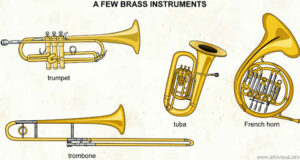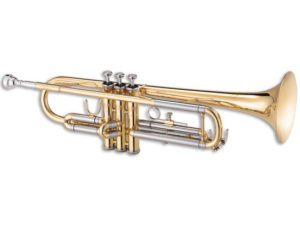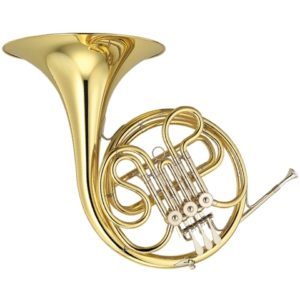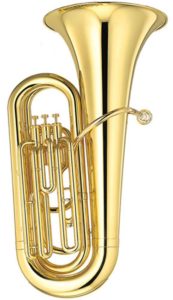The Brass Family Instruments
Revised 21 Sep’2023 by Instruments for Music

The brass family instruments are a family of musical instruments that have been used in classical music, military bands, marching bands and popular music. The brass family includes the Trumpet, Trombone, French Horn and Tuba. Brass instruments are usually made from brass but can be made from other materials.
The brass instrument family has a wide range of sounds and is known for their distinctive and versatile sound and can be used in a variety of musical genres.
Brass instruments can be divided into two types
Brass instruments can be divided into two types, cylindrical brass instruments, and conical brass instruments. Cylindrical brass instruments consist of a tube of an even bore that stays the same almost to the end of the instrument, before flaring into a bell, as Conical brass instruments have a bore that widens gradually from an early point in the length of the tube to the bell.
Brass instruments with a cylindrical bore
Brass instruments with a cylindrical bore include the trumpet, trombone, tenor horn, and baritone families. Brass instruments with a conical bore include the French horn, euphonium, tuba, and cornet families.

The trumpet is one of the most recognisable brass instruments and consists of tubing wrapped into a hollow cone shape with a flared opening at one end. When sound is produced by blowing through this opening, the result is an extended range of harmonic overtones and pitches.
Modern trumpets are typically made of brass, but other metals such as copper and bronze were also used when making older models. The pitch depends on the length of tubing from mouthpiece to bell and from bell to bow.
Its bright and piercing sound of the Trumpet is used across different genres such as classical music, jazz, and even pop.

The French Horn is a brass instrument that produces rich and mellow tones using its coiled tubing to create vibrations by blowing air through its mouthpiece. It has a conical shape like other brass instruments, but it’s unique in that it only has three valves instead of four or five. This means that certain notes cannot be played unless they are already present somewhere else in the horn’s range.
Its unique shape and complex valve system allow for a wide range of notes and expressive playing. Whether it’s performing as part of an orchestra or adding depth to a brass ensemble, the French Horn adds a touch of elegance to any musical composition.

The Trombone is another type of brass instrument with a slide mechanism that uses air pressure to make noise through its long tube-like body offering unparalleled flexibility in pitch variation.
From smooth glissandos to powerful staccato passages, this instrument can create a wide range of sounds. Often featured in jazz bands and orchestras, the Trombone adds a vibrant and dynamic element to any musical arrangement.

The Tuba and Sousaphone are two separate instruments but the difference is minor. The Tuba a true powerhouse among brass instruments with a mellower, or warmer tone, than other brass instruments: the longer tubes allow for more of the instrument to vibrate and create warm overtones.
Tubas also tend to be the lowest-pitched of all the horns in the orchestra and provide a solid foundation for any ensemble or orchestra’s low end. Its ability to produce rich bass tones makes it an integral part of symphonic compositions as well as marching bands.
Conclusion Most Popular Types of Brass Instruments
Brass family instruments have bright and powerful rings that can’t be replicated on any other instrument. These instruments will take your breath away in a matter of seconds and will have you listening for more.
Brass Family Instruments contribute greatly to the world of music with their distinct sounds and versatile capabilities. Whether it’s adding elegance or power to a composition or taking centre stage with solo performances – these instruments continue to captivate audiences worldwide with their timeless appeal.
